

 |
Search the Site with

|
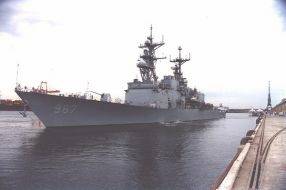 Photo by Andy Wright | 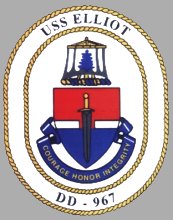 | 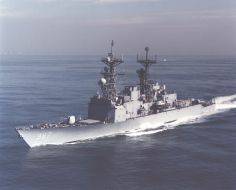 |
Named after Lieutenant Commander Arthur J. Elliot, the USS ELLIOT was the fifth SPRUANCE - class destroyer and the first ship in the Navy named after a hero from the Vietnam War. Last homeported in San Diego, Calif., the ELLIOT has completed a total of twelve deployments and visited more than twenty ports of call. Decommissioned on December 2, 2003, the ELLIOT subsequently joined the mothball fleet in Pearl Harbor, HI. Stricken from the Navy list on April 6, 2004, the ELLIOT was finally sunk as a target on June 24, 2005, during Talisman Saber 2005, a joint exercise of US and Australian Naval forces in the Coral Sea.
| General Characteristics: | Keel Laid: October 15, 1973 |
| Launched: December 19, 1974 | |
| Christened: January 18, 1975 | |
| Commissioned: January 22, 1977 | |
| Decommissioned: December 2, 2003 | |
| Builder: Ingalls Shipbuilding, West Bank, Pascagoula, Miss. | |
| Propulsion system: four General Electric LM 2500 gas turbine engines | |
| Propellers: two | |
| Blades on each Propeller: five | |
| Length: 564,3 feet (172 meters) | |
| Beam: 55,1 feet (16.8 meters) | |
| Draft: 28,9 feet (8.8 meters) | |
| Displacement: approx. 9,200 tons full load | |
| Speed: 30+ knots | |
| Aircraft: two | |
| Armament: two | |
| Crew: approx. 340 |
Crew List:
This section contains the names of sailors who served aboard USS ELLIOT. It is no official listing but contains the names of sailors who submitted their information.
About the Ship's Coat of Arms: The coat of arms of USS ELLIOT serves as a heraldic remembrance of the ship's namesake, Lieutenant Commander Arthur James Elliot, II. The red, white, and blue partitions of the shield are patterned after the insignia of Lieutenant Commander Elliot's command, River Squadron FIFTY-SEVEN. Red is the heraldic symbol of courage, zeal, and leadership; white symbolizes integrity; blue represents devotion and perseverance. The unsheathed sword is symbolic of command, and its position on the shield, point downward, is significant of death in combat.
The coat of arms of USS ELLIOT serves as a heraldic remembrance of the ship's namesake, Lieutenant Commander Arthur James Elliot, II. The red, white, and blue partitions of the shield are patterned after the insignia of Lieutenant Commander Elliot's command, River Squadron FIFTY-SEVEN. Red is the heraldic symbol of courage, zeal, and leadership; white symbolizes integrity; blue represents devotion and perseverance. The unsheathed sword is symbolic of command, and its position on the shield, point downward, is significant of death in combat.
The crest, composed of a mainmast and mainsail, symbolizes the Elliot family's long association with the nautical heritage of their native state of Maine. Generations of the family engaged in the shipbuilding and sailing trades, including Lieutenant Commander Elliot's paternal grandfather and namesake Arthur James Elliot, whose shipbuilding firm launched the last five-masted schooner ever built.
The pine tree emblazoned on the sail is the symbol of the state of Maine.
The ship's motto, "Courage, Honor, Integrity", is representative of those values which characterized Lieutenant Commander Elliot throughout his career.
USS ELLIOT's Commanding Officers:
| Period | Name |
|---|---|
| January 22, 1977 - February 16, 1979 | Commander Donald Gurke, USN |
| February 16, 1979 - January 8, 1981 | Commander Stephen Clarey, USN |
| January 8, 1981 - July 17, 1983 | Commander Douglas Norton, USN |
| July 17, 1983 - April 17, 1984 | Commander Stephan Farrow, USN |
| April 17, 1984 - July 12, 1986 | Commander Eugene Cragg, USN |
| July 12, 1986 - October 19, 1988 | Commander Thomas Mooney, USN |
| October 19, 1988 - December 14, 1990 | Commander Timothy LaFleur, USN |
| December 14, 1990 - July 31, 1992 | Commander Dallas Wilfong, USN |
| July 31, 1992 - April 1, 1994 | Commander Barry Costello, USN |
| April 1, 1994 - January 30, 1996 | Commander Lee Rosenberg, USN |
| January 30, 1996 - October 31, 1997 | Commander Kenneth Graber, USN |
| October 31, 1997 - May 21, 1999 | Commander Steven Strausser, USN |
| May 21, 1999 - January 12, 2001 | Commander Steven DesJardins, USN |
| January 12, 2001 - July 12, 20002 | Commander Jerome Provencher, USN |
| July 12, 2002 - December 2, 2003 | Commander John Nolan, USN |
USS ELLIOT Cruise Books and Pamphlets:
About a very Special Meeting in 1979:
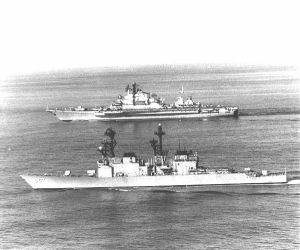 In the Indian Ocean, ELLIOT became part of Carrier Battle Group 77.4, centered around USS MIDWAY (CV 41). The task group included USS ENGLAND (CG 22), commanded by CAPT Hugh L. Webster, USS CAMDEN (AOE 2), commanded by CAPT Guy A. B. Grafius, USS DOWNES (FF 1070), commanded by CDR Charles O. Johnson, and USS ROBISON (DDG 12), commanded by CDR Dana P. French, Jr. The ships conducted routine operations in the Indian Ocean and Gulf of Aden, continuing to show a U.S. presence in those waters, when a Soviet naval task group en route to Vladivostok from the Black Sea also entered the Indian Ocean. The Soviet group included the second of the hybrid cruiser-carriers of the KIEV-class, MINSK (CVHG 117), and two KARA-class cruisers, PETROPAVLOVSK and a sister ship, the amphibious assault ship IVAN ROGOV (LPD 132), and the T-AOR BORIS BUTOMA.
In the Indian Ocean, ELLIOT became part of Carrier Battle Group 77.4, centered around USS MIDWAY (CV 41). The task group included USS ENGLAND (CG 22), commanded by CAPT Hugh L. Webster, USS CAMDEN (AOE 2), commanded by CAPT Guy A. B. Grafius, USS DOWNES (FF 1070), commanded by CDR Charles O. Johnson, and USS ROBISON (DDG 12), commanded by CDR Dana P. French, Jr. The ships conducted routine operations in the Indian Ocean and Gulf of Aden, continuing to show a U.S. presence in those waters, when a Soviet naval task group en route to Vladivostok from the Black Sea also entered the Indian Ocean. The Soviet group included the second of the hybrid cruiser-carriers of the KIEV-class, MINSK (CVHG 117), and two KARA-class cruisers, PETROPAVLOVSK and a sister ship, the amphibious assault ship IVAN ROGOV (LPD 132), and the T-AOR BORIS BUTOMA.
On occasion, ELLIOT conducted surveillance of the Soviet ships and observed their operations. This included VTOL operations by MINSKís YAK-36 Forger light aircraft, KA-25 Hormone helicopter flights from MINSK and PETROPAVLOVSK, and several underway replenishments.
The SPRUANCE-class destroyer's inherent capabilities make it an ideal ship for surveillance operations. Endurance and response from the ship's four gas turbine engines make it possible to conduct such operations with minimal notice and with less fuel logistics concerns. Excellent command and control capabilities assures a thorough, carefully controlled effort.
While carefully briefed teams recorded observations from the bridge and signal bridge, the full range of onboard sensors, including seamen with Instamatic cameras, also "observed" the Soviet task group.
ELLIOTís first encounter with the Soviets occurred while en route to a Seychelle Islands port visit with USS DOWNES. The destroyer found MINSK and BORIS BUTOMA conducting underway alongside refueling. After launching the ship's
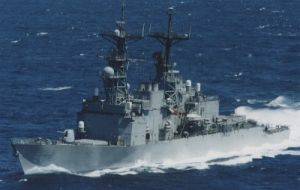 When refueling was completed, MINSK launched a Hormone-B helicopter. With the LAMPS and Hormone airborne concurrently, it was observed that the LAMPS helo was noticeably more maneuverable than the Soviet. When LAMPS returned to the destroyer, film taken during the flight was immediately developed in the ship's hobbyshop darkroom and prints were made for study that evening. The photographic results were excellent.
When refueling was completed, MINSK launched a Hormone-B helicopter. With the LAMPS and Hormone airborne concurrently, it was observed that the LAMPS helo was noticeably more maneuverable than the Soviet. When LAMPS returned to the destroyer, film taken during the flight was immediately developed in the ship's hobbyshop darkroom and prints were made for study that evening. The photographic results were excellent.
ELLIOT maneuvered in the vicinity of MINSK and the Soviet formation freely and reported Alpha Station on the beam or astern the MINSK for a total of five days. On one occasion, while in position astern, close-in observation of the VTOL Forger aircraft operations were conducted, including direct flights overhead while the aircraft were "on final." The noise was deafening on ELLIOTís signal bridge, but the Soviet flights were well photographed.
Some sharp contrasts between Soviet and American operations were observed. UNREP's took six hours to perform for each Soviet ship, refueled one at a time alongside the oiler. Flight deck operations were generally slow and showed few of the most elementary safety precautions being taken. During flight operations, neither the VTOL Forger nor the Hormone helicopter flew out of visible range of the mother ship.
ELLIOT and MINSK exchange visual signals during the maneuvers. The first was from ELLIOT: "I intend to pass up your starboard side." MINSK replied: "Your signal understood. Don't pass too close." The final exchange was an appropriate "Good luck" from ELLIOT to MINSK and the Soviet ship responded: "Good sailing."
"When we left them," said CDR Clarey, ELLIOTís commanding officer, "PETROPAVLOVSK was following smartly in MINSKís wake, maintaining planeguard station. She wasn't doing that when we arrived. They learned that from ELLIOT."
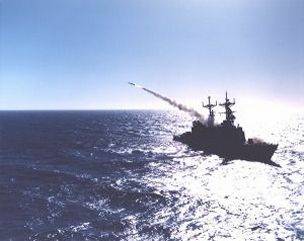
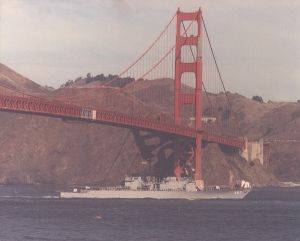
About the Shipís Name, about Lieutenant Commander Arthur J. Elliot:
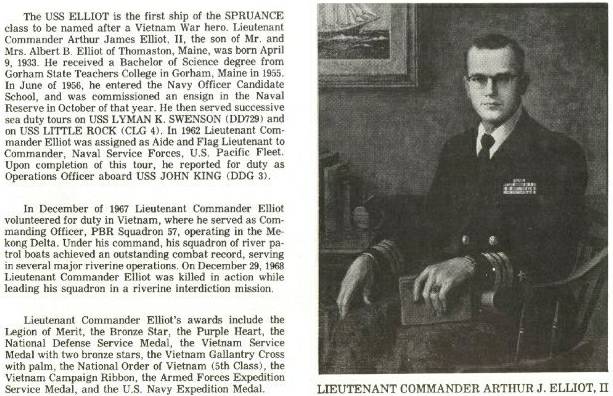
History of USS ELLIOT:
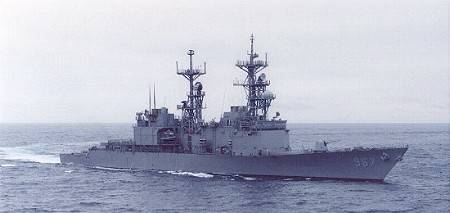
USS ELLIOT Image Gallery:
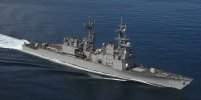 | 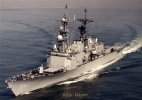 | 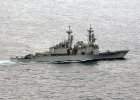 |
The photo below was taken by William Chiu and shows USS ELLIOT at Hong Kong around 1991/1992.
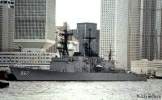 |
 Back to Destroyers list.
Back to Destroyers list.  Back to ships list.
Back to ships list.  Back to selection page.
Back to selection page.  Back to 1st page.
Back to 1st page.